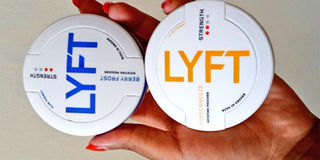Probe nicotine pouches more to prevent addition

Lyft, is a nicotine pouch brand that is being marketed locally. Side effects of nicotine pouches include irritation of the gum, sore mouth, hiccups, nausea and nicotine addiction.
What you need to know:
- When consumed at high levels, nicotine can lead to poisoning and death, but the most common problem with it is its addictive nature.
- The most immediate and visible side-effects of nicotine pouch use can include irritation of the gum, sore mouth, hiccups, nausea and, most importantly, nicotine addiction which increases relapse risk with other tobacco products.
- Learning institutions ought to refocus their energies on better understanding the effects of the pouches so as to assist policymakers to make informed decisions on their effects.
There is a raging debate as to whether nicotine pouches—which are placed under the lip, between the cheek and gum, so that the chemical can be absorbed by the body—should be restricted since they are largely viewed as smokeless tobacco variants.
There is also heightened discussion on whether they contain tobacco.
Scientifically, nicotine is an addictive chemical compound found in tobacco plants.
Its use leads to serious health problems, including increased blood pressure and hardening of arterial walls, which eventually cause heart attacks.
Products with tobacco—such as most e-cigarettes, cigarettes, cigars and hookah tobacco—contain nicotine.
The increasingly popular pouches are colourfully packaged. They contain nicotine, flavourings, sweeteners and plant-based fibres.
Advertising may make them look convenient and appealing but they provide varying amounts of nicotine, which can negatively impact learning, attention span and susceptibility to dependence.
In October 2020, the Health Ministry declared the registration of a brand of nicotine pouches in Kenya illegal, directing the Pharmacy and Poisons Board to de-register them.
But it later allowed their sale on the condition that they are registered as tobacco products.
Introduced in Kenya in 2019 from Sweden, the pouches had gained popularity among young people during the Covid-19 pandemic, when entertainment places were shut down.
Effects
When consumed at high levels, nicotine can lead to poisoning and death, but the most common problem with it is its addictive nature.
It reconfigures how the brain operates and makes people crave tobacco products.
When consumed, users get a slight, brief high from a rush of endorphins (hormones released by the body when in pain or stress).
It also increases the levels of dopamine (hormones that allow feelings of satisfaction, pleasure and motivation) in the reward circuits of the brain. That makes one want to keep taking nicotine products.
With these products not strictly categorised by the US Food and Drug Administration (FDA) as smokeless or combustible tobacco, they are not heavily regulated.
Their long-term health impact is unknown, hence the need for research as to the effects they have on the users and the environment.
The most immediate and visible side-effects of nicotine pouch use can include irritation of the gum, sore mouth, hiccups, nausea and, most importantly, nicotine addiction which increases relapse risk with other tobacco products.
As with other unsafe, addictive, psychoactive drugs legally used by adults—such as alcohol and cannabis—it is in the interest of tobacco control advocates to prevent the use of nicotine, including the pouches, by youth.
Learning institutions ought to refocus their energies on better understanding the effects of the pouches so as to assist policymakers to make informed decisions on their effects.
Public confusion regarding the products will ultimately be corrected by the findings of the research.
Mr Mwangi is manager, corporate communications, at Nacada. [email protected].





